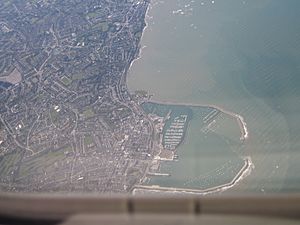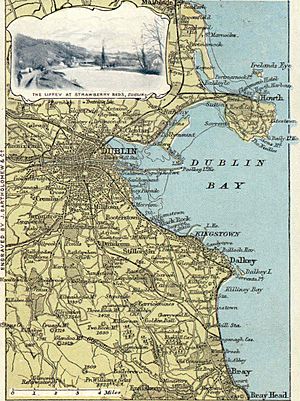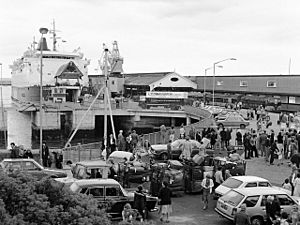Dún Laoghaire Harbour facts for kids
Quick facts for kids Dún Laoghaire Harbour |
|
|---|---|
 |
|
| Location | |
| Country | Ireland |
| Location | Dún Laoghaire |
| Coordinates | 53°17′42″N 6°07′49″W / 53.295062°N 6.130345°W |
| Details | |
| Available berths | 5 |
Dún Laoghaire Harbour is a large port in Dún Laoghaire, Ireland. It was built in the 1800s to protect ships. It also served as a busy stop for mailboats. These boats sailed between Dún Laoghaire and Holyhead.
The town of Dún Laoghaire was once called Kingstown. It was also known as Dun Leary. One part of the harbour, Carlisle Pier, was also known by different names. These included Kingston Pier and the Mailboat Pier.
Contents
Exploring Dún Laoghaire Harbour
Dún Laoghaire Harbour is very big. It has two long walls, called piers. The east and west piers are each about 1 kilometre (0.6 miles) long. They create a sheltered area of about 250 acres (1 square kilometre). The entrance to the harbour is 232 metres (761 feet) wide. The piers are very wide at the bottom. They can be up to 80 metres (262 feet) wide on the seafloor.
Different Sections of the Harbour
The harbour is divided into four main areas. These areas are separated by smaller piers and walls.
- The Old Harbour is in the southwest corner. It was built in 1767. It has a public ramp for boats.
- The Coal Harbour is next to the Old Harbour. It has a ramp for public use.
- The Marina Harbour was built around 2001. It has walls to protect smaller boats.
- The Main Harbour is the largest part. It includes St. Michael's Pier and Carlisle Pier. This area has five places where large ships can dock.
Since October 2018, the local council manages the harbour. This is the Dún Laoghaire–Rathdown County Council. For almost 200 years, a passenger ferry sailed from Dún Laoghaire to Holyhead. This service ended in 2014. Now, large cruise ships sometimes visit the port. Some are too big to enter the harbour. They must anchor outside and use smaller boats to bring passengers ashore.
A Look at the Harbour's Past
The area where the harbour now stands was once a small natural bay. In the 1700s, Dún Laoghaire was a small fishing village. Ships often had trouble getting into Dublin Bay. They would sometimes transfer passengers to the cove at Dún Laoghaire.
Building the Harbour
In 1767, a pier was built. But it soon filled with sand. It became known as the "Dry Pier." In the early 1800s, William Bligh (famous from the Bounty mutiny) mapped Dublin Bay. He suggested building a safe harbour at Dún Laoghaire.
A big problem was shipwrecks. Many ships were lost in storms. In 1807, two ships, the Rochdale and Prince of Wales, sank. This made people realize a safe harbour was needed. Dún Laoghaire was chosen because it had deep water close to shore.
Construction of the East Pier began in 1817. John Rennie the Elder designed it. He worried that one pier would fill with sand. So, work on the Western pier started soon after.
In 1820, King George IV visited Ireland. He left from the harbour. After his visit, Dunleary was renamed Kingstown. This name was used for almost 100 years. The harbour was briefly called the Royal Harbour of George the Fourth.
By 1824, the partially built harbour was already helping. Over 3,000 boats found shelter there. In 1826, Kingstown harbour became very important. It started hosting the mail packet service. This service carried mail and passengers. It moved from Howth, which had problems with sand.
Connecting by Rail
In December 1834, the Dublin and Kingstown Railway opened. It connected Dublin to the West Pier. In 1837, Victoria Wharf was built. It is now called St. Michael's Wharf. The railway line was extended to this new wharf.
By 1842, the harbour was finished. It was the largest man-made harbour in Western Europe. The East Pier lighthouse was completed. More improvements followed. Traders Wharf was finished in 1855. Carlisle Pier was completed in 1856. The West Pier lighthouse was also built in the mid-1850s. The railway line was extended to Bray in 1856.
In 1920, Kingstown changed its name back to Dún Laoghaire. In 1924, the harbour was officially renamed "Dun Laoghaire Harbour."
Carlisle Pier's Story
Construction of Carlisle Pier began in 1853 and finished in 1855. A railway station opened on the pier in 1859. The pier was named after the Earl of Carlisle. He was the Lord Lieutenant of Ireland at the time. Many Irish people left Ireland from this pier to start new lives.
The RMS Leinster was a ship that sailed from this pier. In October 1918, it was sunk by a German U-boat.
In 1953, a passenger lounge was built on the pier. More buildings were added in the 1960s. In 2009, some of these newer buildings were taken down. The old cast-iron parts from the 1850s were kept. Today, the pier is used for parking cars. It also stores boats and hosts special events like funfairs.
Carlisle Pier Railway Station
The railway station on Carlisle Pier opened in 1859. It helped passengers and mail connect between trains and ferries. Trains could go to Westland Row (now Pearse station). After 1891, trains could also go to other major stations. The station closed on October 11, 1980. This was because the curved platform was not suitable for modern trains.
St. Michael's Pier
The first car ferry service started in Dún Laoghaire in 1965. It used a temporary area on the East Pier. A special pier for car ferries, St. Michael's Pier, opened in 1969. It was 175 metres (574 feet) long. It could handle 650 cars per day.
Who Uses the Harbour Today?
Dún Laoghaire Harbour is now mostly used for fun activities. People enjoy walking along the east and west piers. Many water sports happen here. These include rowing, canoeing, and yachting. There is a marina and several local clubs.
You can take a boat trip across Dublin Bay. You can also go on private fishing trips. Dún Laoghaire used to have many fishing boats. But this changed when Howth became a main fishing port.
The harbour is home to the RNLI lifeboat station. They have boats for rescues close to shore and in all weather. The harbour is also the base for the Commissioners of Irish Lights. This group manages lighthouses. The National Maritime Museum of Ireland is also located here.
In 2017, the harbour welcomed the Irish Naval Service. Their ship, the LÉ Eithne, is often linked with the harbour. While regular passenger ferries stopped in 2015, cruise ships still visit sometimes.




